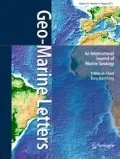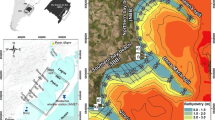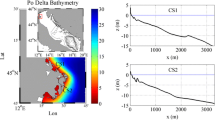Abstract
This research uses a process-based model (Delft3D), validated with measured wave data, to investigate the controls that a cuspate shoreline and its associated submerged morphology have on wave generation, propagation, and attenuation within a large elongated lagoon (Lagoa dos Patos, Brazil). A method based on the Energy-Flux-Method was applied to the historical wind dataset to define representative wind cases to be used as forcing conditions in the model. The results show that, during extreme wind conditions, the spits dissipate wave energy in the lagoon. This (wave attenuation and the wave sheltering effect) controls the stability of the adjacent coastline. The wave attenuation varies between 18% and 46% along the submerged spit depending on the crest width and the amplitude of the incident waves. Waves are mainly attenuated in the proximal and central portions of the spits where the spits are wider, resulting in a reduced transmitted energy to the adjacent coastline, while larger waves are also attenuated on the distal end of the spits. The degree of attenuation depends on the direction of wave generation, the respective fetch, the spit width, and the water depth. A strong relationship of mutual co-adjustment between the morphology and the wave field results in a very low occurrence of oblique wave angles of incidence, especially for waves propagating across the long lagoon axis. Furthermore, the wave attenuation over the spits is also responsible for its progressive erosion, which, from decades to centuries, may lead to an increase of changes on the lagoon shorelines.







Similar content being viewed by others
References
Allard J, Bertin X, Chaumillon E, Pouget F (2008) Sand spit rhythmic development: a potential record of wave climate variations? Arçay spit, western coast of France. Mar Geol 253:107–131. https://doi.org/10.1016/j.margeo.2008.05.009
Andrade Neto JS, Rigon LT, Toldo EE Jr, Schetinni F (2012) Descarga sólida em suspensão do sistema fluvial do Guaíba, RS, e sua variabilidade temporal. Pesquisas em Geociências 39(2):161–171
Aronow S (1982) Lakes, coastal morphology. In: Beaches and coastal geology. Encyclopedia of Earth Science. Springer, Boston
Ashton AD, Murray AB (2006a) High-angle wave instability and emergent shoreline shapes: 1. Modeling of sand waves, flying spits, and capes. J Geophys Res 111(F04011):1–19. https://doi.org/10.1029/2005JF000422
Ashton AD, Murray AB (2006b) High-angle wave instability and emergent shoreline chapes: 2. Wave climate analysis and comparisons to nature. J Geophys Res 111(F04012):1–17. https://doi.org/10.1029/2005JF000423
Ashton A, Murray AB, Arnault O (2001) Formation of coastline features by large-scale instabilities induced by high-angle waves. Nature 414(6861):296–300. https://doi.org/10.1038/415666a
Ashton AD, Murray AB, Littlewood R, Lewis DA, Hong P (2009) Fetch-limited self-organization of elongated water bodies. Geology 37(2):18–190
Battjes JA, Janssen JPFM (1978) Energy loss and set-up due to breaking of random waves. In: Proceedings of 16th conference on coastal engineering, Hamburg, pp 569–587
Benedet L, Dobrochinski JPF, Walstra DJR, Klein AHF, Ranasingle R (2016) Coast Eng 112:69–86. https://doi.org/10.1016/j.coastaleng.2016.02.005
Booij N, Ris RC, Holthuijen LH (1999) A third-generation wave model for coastal regions, 1. Model description and validation. J Geophys Res 104(C4):7649–7666. https://doi.org/10.1029/98JC02622
Bouws E, Komen GJ (1983) On the balance between growth and dissipation in an extreme, depth-limited wind-sea in the southern North Sea. J Phys Oceanogr 13:1653–1658
Carter RWG (1988) Tidal and lake coasts. In: Carter RWG (Eds.) Coastal environments; an introduction to the physical, ecological and cultural systems of coastlines, n°1st.ed. San Diego 92101: Academic Press Inc. cap. n° 4, p.151–198
Carter RWG, Woodrofe CD (1994) Coastal evolution: Late Quaternary shoreline morphodynamics. Cambridge University Press, Cambridge, p 517
Cowell PJ, Thom BG (1994) Morphodynamics of coastal evolution. In: RWG C, Woodroffe CD (eds) Coastal evolution. Cambridge University Press, Cambridge, pp 33–86
Delaney PJV (1965) Fisiografia e Geologia de Superfície da Planície Costeira do Rio Grande do Sul. Publicação Especial da Escola de Geologia (6). Porto Alegre, UFRGS, p 105
Eldeberky Y (1996) Nonlinear transformations of wave spectra in the nearshore zone, Ph.D Thesis, Fac. of Civil Engineering, Delft University of Technology, pp 203
Eldeberky Y, Battjes JA (1995) Parameterization of triad interactions in wave energy models. Proceedings of coastal dynamics '95, 140-149
Ells K, Murray AB (2012) Long-term, non-local coastline responses to local shoreline stabilization. Geophys Res Lett 39(L19401):1–7. https://doi.org/10.1029/2012GL052627
Escudero M, Silva R, Hesp PA, Mendoza E (2019) Morphological evolution of the sandspit at Tortugueros beach, Mexico. Mar Geol 407:16–31. https://doi.org/10.1016/j.margeo.2018.10.002
Fernandes EHL, Dyer KR, Moller OO, Niencheski LFH (2002) The Patos Lagoon hydrodynamics during an El Niño event (1998). Cont Shelf Res 22(11-13):1699–1713
Fernandes EHL, Mariño-Tapia I, Dyer KR, Moller OO (2004) The attenuation of tidal and subtidal oscillations in the Patos lagoon estuary. Ocean Dyn 54(3–4):348–359. https://doi.org/10.1007/s10236-004-0090-y
FitzGerald DM, Buynevich IV (2009) Coastal barriers. In: Isla FI, Iribarne O (eds) Coastal zones and estuaries. UNESCO—Encyclopedia of Life Support Systems, London, pp 164–189
French J, Payo A, Muray B, Orford J, Eliot M, Cowell P (2016) Appropriate complexity for the prediction of coastal and estuarine geomorphic behavior at decadal to centennial scales. Geomorphology 256:3–16
Hallermeier RJ (1981) A profile zonation for seasonal sand beaches from wave climate. Coastal Engineering 4:253–277. https://doi.org/10.1016/0378-3839(80)90022-8
Hardy TA, Young IR, Nelson RC, Goulay MR (1990) Wave attenuation on an offshore coral reef. In: Proceedings of the 22nd international conference on coastal engineering, Delft, pp 330–344. https://doi.org/10.1061/9780872627765.027
Hasselmann K, Barnett TP, Bouws E et al (1973) Measurements of wind-wave growth and swell decay during the Joint North Sea Wave Project (JONSWAP). Dtsch Hydrogr Z. E. A. 12(A8):1–95
Hegge B, Elliot I, Hsu J (1996) Sheltered sandy beaches of southwestern Australia. J Coast Res 12(3):748–760
Héquette A, Ruz MH (1991) Spit and barrier island migration in the southeasthern Canadian Beaufourt Sea. J Coast Res 7(3):677–698
Jackson NL, Nordstom KF (1992) Site specific controls on wind and wave processes and beach mobility on estuarine beaches in New Jersey, U.S.A. J Coast Res 8(1):88–98
Jackson LA, Corbett B, Salyer A, Mocke G, Smit F, Strauss D, Tomlinson R (2010) Low crested reef breakwaters—theory illustrated by Arabian Gulf Projects. In: Proceedings of the 2nd International Conference on Coastal Zone Engineering and Management (Arabian Coast 2010). Muscat
Klein AHF (2012) Regional climate. In: Seeliger U, Odebrecht C, Castello JP (eds) Subtropical convergence environments: the coast and sea in the southwestern. Springer-Verlag, Heidelberg, pp 5–7
Komen GJ, Hasselmann S, Hasselman K (1984) On the existence of a fully-developed wind-sea spectrum. J Phys Oceanogr 14:1271–1285. https://doi.org/10.1175/1520-0485(1984)014<1271:OTEOAF>2.0.CO;2
Lesser GR, Roelvink JA, van Kester JATM, Stelling GS (2004) Development and validation of a three-dimentional morphological model. Coast Eng 51(8):883–915. https://doi.org/10.1016/j.coastaleng.2004.07.014
Lin W, Sanford LP, Suttles SE (2002) Wave measurement and modeling in Chesapeake Bay. Cont Shelf Res 22:2673–2686. https://doi.org/10.1016/S0278-4343(02)00120-6
López-Ruiz A, Ortega-Sánchez M, Baquerizo A, Navidad D, Losada MA (2012) Nonuniform alongshore sediment transport induced by coastline curvature. Coast Eng Proc 33:1–10. https://doi.org/10.9753/icce.v33.sediment.29
López-Ruiz A, Ortega-Sánches M, Baquerizo A, Losada MA (2014) A note on alongshore sediment transport on weakly curvilinear coasts and its implcations. Coast Eng 88:143–153. https://doi.org/10.1016/j.geomorph.2012.03.001
López-Ruiz A, Solari S, Ortega-Sánches M, Losada MA (2015) A simple approximation for wave refraction—application to the assessment of the nearshore wave directionality. Ocean Model 96:324–333. https://doi.org/10.1016/j.ocemod.2015.09.007
Lowe RJ, Falter JL, Bandet MD, Pawlack G, Atkinson MJ, Monismith SG, Koseff JR (2005) Spectral wave dissipation over a barrier reef. J Geophys Res 110(C04001):1–16. https://doi.org/10.1029/2004JC002711
Madsen OS, Poon YK, Grabe HC (1988) Spectral wave attenuation by bottom friction: theory. In: Procedings of 21th international conference on coastal engineering. American Society of Civil Engineering, New York, pp 492–504. https://doi.org/10.9753/icce.v21.%25p
Miranda IM, Toldo EE Jr, Klein AHF, Vieira da Silva G (2019) Shoreline evolution of lagoon sandy spits and adjacent beaches, Lagoa dos Patos, Brazil. J Coast Res 35(5):1010–1023 Coconut Creek (Florida), ISSN 0749-0208
Moller OO, Lorenzzentti JA, Stech JL, Mata MM (1996) The Patos lagoon summertime circulation and dynamics. Cont Shelf Res 16(3):335–351. https://doi.org/10.1016/0278-4343(95)00014-R
Murray AB, Ashton AD (2013) Instability and finite-amplitude self-organization of large-scale coastline shapes. Phil Trans R Soc A 371:1–15. https://doi.org/10.1098/rsta.2012.0363
Nicholls RJ, Townend IH, Bradbury AP, Ramsbottom D, Day SA (2013) Planning for long-term coastal change: experience from England and Wales. Ocean Eng 71:3–16
Nobre CA, Cavalcanti MAG, Nobre P, Kayano MT, Rao VB, Bonatti JP, Satyamurti P, Uvo CB, Cohen JC (1986) Aspectos da climatologia dinâmica do Brasil. Climanálise número especial
Nordstrom KF (2005) Bay beaches. In: Schwartz M (ed) Encyclopedia of earth sciences series. Springer, Netherlands, pp 129–130
Park JV, Wells JT (2007) Spit growth and downdrift erosion: results of longshore transport modelling and morphologic analysis at the Cape Lookout cuspate foreland. J Coast Res 23(3):553–568. https://doi.org/10.2112/03-0116.1
Petersen D, Deigaard R, Fredsoe J (2008) Modelling the morphology of sandy spits. Coast Eng 55:171–184
Ris RC, Holthuijsen LH, Booji N (1999) A third-generation wave model for coastal regions, 2. Verification. J Geophys Res 104(C4):7667–7681. https://doi.org/10.1029/1998JC900123
Roelvink JA (2006) Coastal morphodynamic evolution techniques. Coast Eng 53(2):277–287. https://doi.org/10.1016/j.coastaleng.2005.10.015
Rosen PS (1975) Origin and progress of cuspate spit shorelines. In: Cronin LE (ed) Estuarine research, vol II. Academic press, New York, pp 77–92. https://doi.org/10.13140/2.1.3070.7208
Saraiva JMB, Bedran C, Carneiro C (2003) Monitoring storm surges on Cassino Beach, RS, Brazil. In: Klein AHF, Finkl CW, Rorig LR, Santana GG, Diehl FL, Calliari LJ (eds.), Proceedings of the Brazilian symposium on sandy beaches: morphodynamics, ecology, uses, hazards and management. Journal of Coastal Research, special issue no. 35, pp. 323–331
Schossler V, Simões JC, Aquino FE, Viana DR (2018) Precipitation anomalies in the Brazilian southern coast related to the SAM and ENSO climate variability modes. Braz J Water Res 23(14):1–10
Stech JL, Lorenzzeti JA (1992) The response of the South Brazil bight to the passage of wintertime cold fronts. J Geophys Res 97(C6):9507–9520. https://doi.org/10.1029/92JC00486
Thornton ED, Dalrymple, T, Drake T, Elgar S, Gallagher E, Guza B, Hay A, Holman R, Kaihatu J, Lippman T, Ozkan-Haller T (2000) Nearshore Processes Research. Report Based on the Nearshore Research Workshop. St. Petersburg, Florida, September 14–16
Toldo EE Jr (1991) Morfodinâmica da Laguna dos Patos, Rio Grande do Sul. Pesquisas em Geociências 18(1):58–63. https://doi.org/10.22456/1807-9806.21362
Toldo EE Jr, Almeida LESB, Côrrea ICS (2003) Forecasting shoreline changes of Lagoa dos Patos lagoon, Brazil. J Coast Res 19:43–50
Toldo EE Jr, Almeida LESB, Corrêa ICS, Ferreira ER, Gruber NLS (2006a) Wave prediction along Lagoa dos Patos coastline, southern Brazil. Atlântica 28(2):87–95
Toldo EE Jr, Dillenburg SR, Côrrea ICS, Almeida LESB, Weschenfelder J, Gruber NLS (2006b) Sedimentação de longo e curto período na Lagoa dos Patos, Sul do Brasil. Pesquisas em Geociências 33(2):79–86. https://doi.org/10.22456/1807-9806.19516
Tomazelli LJ (1993) O Regime de Ventos e a Taxa de Migração das Dunas Eólicas Costeiras do Rio Grande do Sul, Brasil. Pesquisas em Geociências 20(1):18–26. https://doi.org/10.22456/1807-9806.21278
Tomazelli LJ, Dillenburg SR, Villwock JA (2000) Late Quaternary history of Rio Grande do Sul coastal plain, southern Brazil. Rev Bras Geocienc 30(3):470–472
Van Der Westhuysen AJ, Zijlema M, Battjes JA (2007) Nonlinear saturation-based whitecapping dissipation in SWAN for deep and shallow water. Coast Eng 54:151–170. https://doi.org/10.1016/j.coastaleng.2006.08.006
Vaz AC, Moller AA, Almeida TL (2006) Análise quantitativa da descarga dos rios afluentes da Lagoa dos Patos. Atlântica (Rio Grande) 28(1):13–23
Vieira da Silva G, Murray T, Strauss D (2018) Longshore wave variability along non-straight coastlines. Estuar Coast Shelf Sci 212(15):318–328. https://doi.org/10.1016/j.ecss.2018.07.022
Villwock JA (1984) Geology of the coastal province of Rio Grande do Sul, southern Brazil. A synthesis. Pesquisas em Geociências 16(16):5–49
Westhuysen AJ (2010) Modeling of depth-induced wave breaking under finite-depth wave growth conditions. J Geophys Res 115(C01008):1–19. https://doi.org/10.1029/2009JC005433
Xu F, Perrie W, Solomon S (2013) Shallow water dissipation processes for wind waves off the Mackenzie Delta. J Atmos Ocean 51(3):296–308. https://doi.org/10.1080/07055900.2013.794123
Zenkovitch VP (1959) On the genesis of the cuspate spits along lagoon shores. J Geol 67(3):269–277
Acknowledgments
The authors would like to acknowledge reviewers, especially reviewer 2, for their helpful comments which have greatly contributed to improving the paper. We also acknowledge PFRH-Petrobrás program no. PB-215, for the student grant provided to the full-engagement development of the first author’s Ph.D. thesis, and the research agency CAPES for funding an almost 1-year internship at the Griffith Centre for Coastal Management (GCCM), Griffith University (AU), which resulted in the present work. Productivity scholarship 1D CNPQ 301597/2018-9. The first author would also like to thank the GCCM Team for the good opportunity of working together, for their nice reception, willingness to share knowledge, and patience during the learning process. We also thank Rede Ondas Project (https://redeondas.furg.br/pt/), an initiative from the Intergovernmental Oceanographic Commission of UNESCO, coordinated by the Federal University of Rio Grande (FURG-Brazil) for providing the measured wave data (Datawell Waverider—Mark III) for the model validation.
Author information
Authors and Affiliations
Corresponding author
Additional information
Publisher’s note
Springer Nature remains neutral with regard to jurisdictional claims in published maps and institutional affiliations.
Electronic supplementary material
ESM 1
(PDF 998 kb).
Rights and permissions
About this article
Cite this article
Malheiros Miranda, I., Toldo, E.E., da Fontoura Klein, A.H. et al. The role of cuspate spits on wave attenuation and energy redistribution in a coastal lagoon, Lagoa dos Patos, Brazil. Geo-Mar Lett 40, 1069–1086 (2020). https://doi.org/10.1007/s00367-019-00632-9
Received:
Accepted:
Published:
Issue Date:
DOI: https://doi.org/10.1007/s00367-019-00632-9




